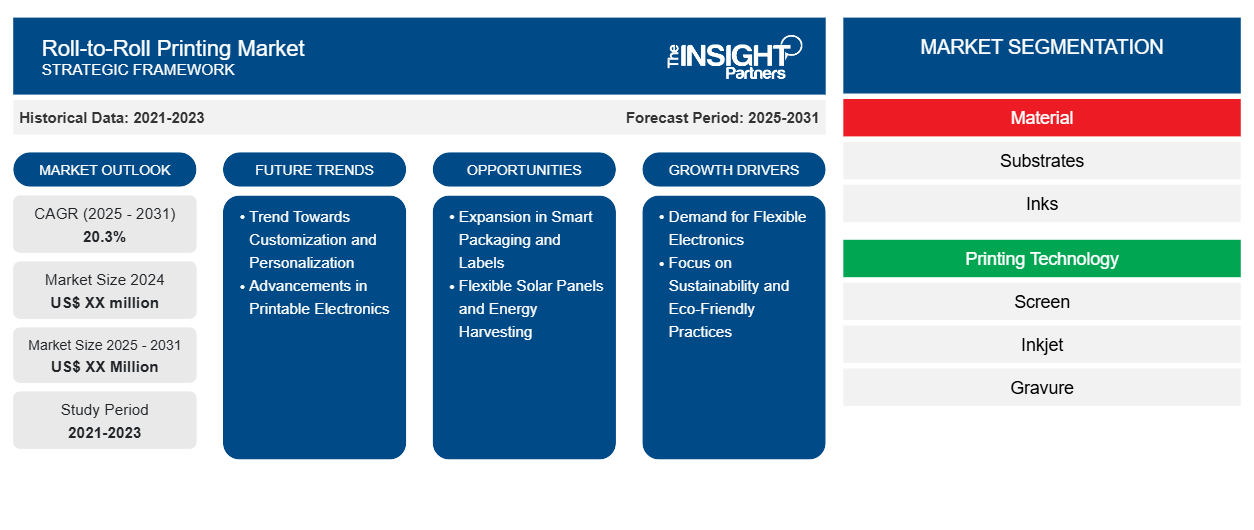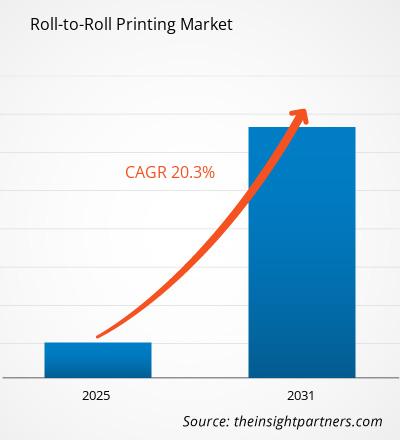من المتوقع أن يسجل سوق الطباعة من لفة إلى لفة معدل نمو سنوي مركب بنسبة 20.3٪ من عام 2025 إلى عام 2031، مع توسع حجم السوق من XX مليون دولار أمريكي في عام 2024 إلى XX مليون دولار أمريكي بحلول عام 2031.
يُقسّم التقرير حسب المواد (الركائز، الأحبار)؛ وتقنيات الطباعة (الشاشات، نفث الحبر، الحفر، الفليكسوغرافي، وغيرها)؛ والتطبيقات (الشاشات، المستشعرات، البطاريات، تحديد الهوية بموجات الراديو، وغيرها)؛ وقطاعات الاستخدام النهائي (الرعاية الصحية، الإلكترونيات الاستهلاكية، الفضاء والدفاع، البناء والعمارة، وغيرها). ويُفصّل التحليل العالمي على المستوى الإقليمي والدول الرئيسية. ويُقدّم التقرير القيمة بالدولار الأمريكي للتحليل والقطاعات المذكورة أعلاه.
غرض التقرير
يهدف تقرير "سوق الطباعة من لفة إلى لفة" الصادر عن "ذا إنسايت بارتنرز" إلى وصف المشهد الحالي والنمو المستقبلي، وأهم العوامل المحفزة، والتحديات، والفرص المتاحة. وسيوفر هذا التقرير رؤى ثاقبة لمختلف أصحاب المصلحة في قطاع الأعمال، مثل:
- مزودي/مصنعي التكنولوجيا: لفهم ديناميكيات السوق المتطورة ومعرفة فرص النمو المحتملة، وتمكينهم من اتخاذ قرارات استراتيجية مستنيرة.
- المستثمرون: لإجراء تحليل شامل للاتجاهات فيما يتعلق بمعدل نمو السوق، والتوقعات المالية للسوق، والفرص الموجودة عبر سلسلة القيمة.
- الهيئات التنظيمية: لتنظيم السياسات ومراقبة الأنشطة في السوق بهدف تقليل الانتهاكات والحفاظ على ثقة المستثمرين ودعم سلامة السوق واستقرارها.
تجزئة سوق الطباعة من لفة إلى لفة
مادة
- الركائز
- الأحبار
تكنولوجيا الطباعة
- شاشة
- نفث الحبر
- الحفر
- طباعة فلكسوغرافية
طلب
- شاشات العرض
- أجهزة الاستشعار
- البطاريات
- تقنية تحديد الهوية بموجات الراديو
صناعة الاستخدام النهائي
- الرعاية الصحية
- الالكترونيات الاستهلاكية
- الفضاء والدفاع
- البناء والعمارة
ستحصل على تخصيص لأي تقرير - مجانًا - بما في ذلك أجزاء من هذا التقرير، أو تحليل على مستوى الدولة، وحزمة بيانات Excel، بالإضافة إلى الاستفادة من العروض والخصومات الرائعة للشركات الناشئة والجامعات
سوق الطباعة من لفة إلى لفة: رؤى استراتيجية

-
احصل على أهم اتجاهات السوق الرئيسية لهذا التقرير.ستتضمن هذه العينة المجانية تحليل البيانات، بدءًا من اتجاهات السوق وحتى التقديرات والتوقعات.
عوامل نمو سوق الطباعة من لفة إلى لفة
- الطلب على الإلكترونيات المرنة: شكّل الطلب المتزايد على الإلكترونيات المرنة والقابلة للارتداء دافعًا رئيسيًا لطباعة R2R. تتطلب الشاشات المرنة، والمستشعرات، وشاشات OLED عملية إنتاج قادرة على التعامل مع مواد دقيقة ورقيقة ومرنة. تُعد الطباعة من لفة إلى لفة مثالية لهذه التطبيقات، حيث توفر إنتاجية عالية ودقة عالية وقابلية للتوسع. ومع نمو السوق العالمية لأجهزة مثل أجهزة تتبع الصحة القابلة للارتداء، والهواتف الذكية المرنة، والمنسوجات الذكية، سيستمر الطلب على تقنية طباعة R2R في الارتفاع.
- التركيز على الاستدامة والممارسات الصديقة للبيئة: تتزايد أهمية الاستدامة في عمليات التصنيع في مختلف القطاعات، وتُقدم الطباعة من لفة إلى لفة بديلاً صديقًا للبيئة أكثر من الطرق التقليدية. تتميز عمليات الطباعة بتقنية R2R بقدرتها على تقليل النفايات، وخفض استهلاك الطاقة، واستخدام موارد أقل بفضل طبيعتها المستمرة. كما تُسهم إمكانية الطباعة على مواد صديقة للبيئة وقابلة للتحلل الحيوي في تحقيق أهداف الاستدامة. وفي ظل الضغوط التي تواجهها الشركات لتبني ممارسات أكثر مراعاةً للبيئة، تُصبح طباعة R2R حلاً جذابًا للمُصنّعين المهتمين بالبيئة.
اتجاهات مستقبلية في سوق الطباعة من لفة إلى لفة
- التوجه نحو التخصيص والتخصيص: مع تزايد طلب المستهلكين على المنتجات المُخصصة والمصممة حسب الطلب، تُوفر تقنية طباعة R2R حلاً مثاليًا للتخصيص على نطاق واسع. وينطبق هذا بشكل خاص على قطاعات مثل التعبئة والتغليف والمنسوجات والملصقات، حيث أصبح التخصيص عاملًا رئيسيًا للتميز. تتيح طباعة R2R إنتاجًا مرنًا حسب الطلب، مما يُمكّن المُصنّعين من إنتاج كميات صغيرة من المنتجات الفريدة بأقل وقت إعداد. ومن المتوقع أن يتوسع هذا التوجه، لا سيما في القطاعات التي تُركز على تفضيلات المستهلكين الفردية، مثل الأزياء والمواد الترويجية.
- التطورات في مجال الإلكترونيات القابلة للطباعة: يشهد مجال الإلكترونيات القابلة للطباعة تطورًا سريعًا، مما يُتيح فرصةً قيّمةً لسوق الطباعة من لفة إلى لفة. تُستخدم طباعة R2R في إنتاج مكونات إلكترونية مرنة وخفيفة الوزن، مثل المستشعرات والبطاريات والشاشات. ومع استمرار تطور التكنولوجيا، ستزداد الحاجة إلى طباعة R2R لإنتاج هذه الأجهزة المعقدة بكفاءة. تُمكّن الابتكارات في المواد، مثل أشباه الموصلات العضوية والأحبار الموصلة، من ابتكار أجهزة إلكترونية من الجيل التالي، مما يجعل طباعة R2R لاعبًا رئيسيًا في هذا القطاع الناشئ.
فرص سوق الطباعة من لفة إلى لفة
- التوسع في التغليف الذكي والملصقات: تُتيح الطباعة من لفة إلى لفة فرصًا كبيرة في سوق التغليف الذكي والملصقات المتنامي. ويتزايد الطلب على التغليف التفاعلي الرقمي، مع تطبيقات تتراوح من رموز الاستجابة السريعة (QR code) إلى علامات تحديد الترددات الراديوية (RFID). تُقدم طباعة R2R حلاً فعالاً واقتصاديًا لإنتاج هذه الميزات المعقدة للتغليف بكميات كبيرة. ومع سعي صناعات مثل الأغذية والمشروبات ومستحضرات التجميل والأدوية إلى دمج تغليف أكثر تفاعلية وغني بالمعلومات، سيستمر الطلب على طباعة R2R في التزايد، مما يوفر مصادر دخل جديدة للمصنعين.
- الألواح الشمسية المرنة وتجميع الطاقة: تشهد مصادر الطاقة المتجددة، وخاصةً الطاقة الشمسية، نموًا متسارعًا، وتلعب الطباعة من لفة إلى لفة دورًا محوريًا في إنتاج الألواح الشمسية المرنة. تتيح طباعة R2R إنتاج ألواح شمسية خفيفة الوزن واقتصادية، يمكن دمجها في مختلف الأسطح، مثل النوافذ والأسقف وحتى المنسوجات. هذه المرونة تجعلها مثالية لمجموعة واسعة من التطبيقات. ومع تزايد الطلب العالمي على الطاقة النظيفة، ستُعتبر طباعة R2R بشكل متزايد طريقةً أساسيةً لتصنيع ألواح شمسية وأجهزة تجميع طاقة منخفضة التكلفة وفعالة.
رؤى إقليمية حول سوق الطباعة من لفة إلى لفة
قام محللو شركة "ذا إنسايت بارتنرز" بشرح شامل للاتجاهات والعوامل الإقليمية المؤثرة في سوق الطباعة من اللفة إلى اللفة خلال فترة التوقعات. ويناقش هذا القسم أيضًا قطاعات سوق الطباعة من اللفة إلى اللفة ونطاقه الجغرافي في أمريكا الشمالية، وأوروبا، وآسيا والمحيط الهادئ، والشرق الأوسط وأفريقيا، وأمريكا الجنوبية والوسطى.
نطاق تقرير سوق الطباعة من لفة إلى لفة
| سمة التقرير | تفاصيل |
|---|---|
| حجم السوق في عام 2024 | XX مليون دولار أمريكي |
| حجم السوق بحلول عام 2031 | XX مليون دولار أمريكي |
| معدل النمو السنوي المركب العالمي (2025 - 2031) | 20.3% |
| البيانات التاريخية | 2021-2023 |
| فترة التنبؤ | 2025-2031 |
| القطاعات المغطاة |
حسب المادة
|
| المناطق والبلدان المغطاة |
أمريكا الشمالية
|
| قادة السوق وملفات تعريف الشركات الرئيسية |
|
كثافة اللاعبين في سوق الطباعة من لفة إلى لفة: فهم تأثيرها على ديناميكيات الأعمال
يشهد سوق الطباعة من لفة إلى لفة نموًا سريعًا، مدفوعًا بتزايد طلب المستخدم النهائي نتيجةً لعوامل مثل تطور تفضيلات المستهلكين، والتقدم التكنولوجي، وزيادة الوعي بمزايا المنتج. ومع تزايد الطلب، تعمل الشركات على توسيع عروضها، والابتكار لتلبية احتياجات المستهلكين، والاستفادة من الاتجاهات الناشئة، مما يعزز نمو السوق.

- احصل على نظرة عامة على أهم اللاعبين الرئيسيين في سوق الطباعة من لفة إلى لفة
نقاط البيع الرئيسية
- التغطية الشاملة: يغطي التقرير بشكل شامل تحليل المنتجات والخدمات والأنواع والمستخدمين النهائيين لسوق الطباعة من لفة إلى لفة، مما يوفر مشهدًا شاملاً.
- تحليل الخبراء: تم تجميع التقرير على أساس الفهم العميق لخبراء الصناعة والمحللين.
- المعلومات الحديثة: يضمن التقرير أهمية الأعمال التجارية بسبب تغطيته للمعلومات الحديثة واتجاهات البيانات.
- خيارات التخصيص: يمكن تخصيص هذا التقرير لتلبية متطلبات العملاء المحددة وتلبية استراتيجيات العمل بشكل مناسب.
لذا، يُمكن لتقرير البحث حول سوق الطباعة من لفة إلى لفة أن يُساعد في تمهيد الطريق لفهم سيناريوهات الصناعة وآفاق نموها. ورغم وجود بعض المخاوف المُبررة، إلا أن فوائد هذا التقرير الإجمالية تفوق عيوبه.
- التحليل التاريخي (سنتان)، سنة الأساس، التوقعات (7 سنوات) مع معدل النمو السنوي المركب
- تحليل PEST و SWOT
- حجم السوق والقيمة / الحجم - عالمي، إقليمي، بلد
- الصناعة والمنافسة
- مجموعة بيانات إكسل
التقارير الحديثة
شهادات العملاء
سبب الشراء
- اتخاذ قرارات مدروسة
- فهم ديناميكيات السوق
- تحليل المنافسة
- رؤى العملاء
- توقعات السوق
- تخفيف المخاطر
- التخطيط الاستراتيجي
- مبررات الاستثمار
- تحديد الأسواق الناشئة
- تحسين استراتيجيات التسويق
- تعزيز الكفاءة التشغيلية
- مواكبة التوجهات التنظيمية






















 احصل على عينة مجانية ل - سوق الطباعة من لفة إلى لفة
احصل على عينة مجانية ل - سوق الطباعة من لفة إلى لفة